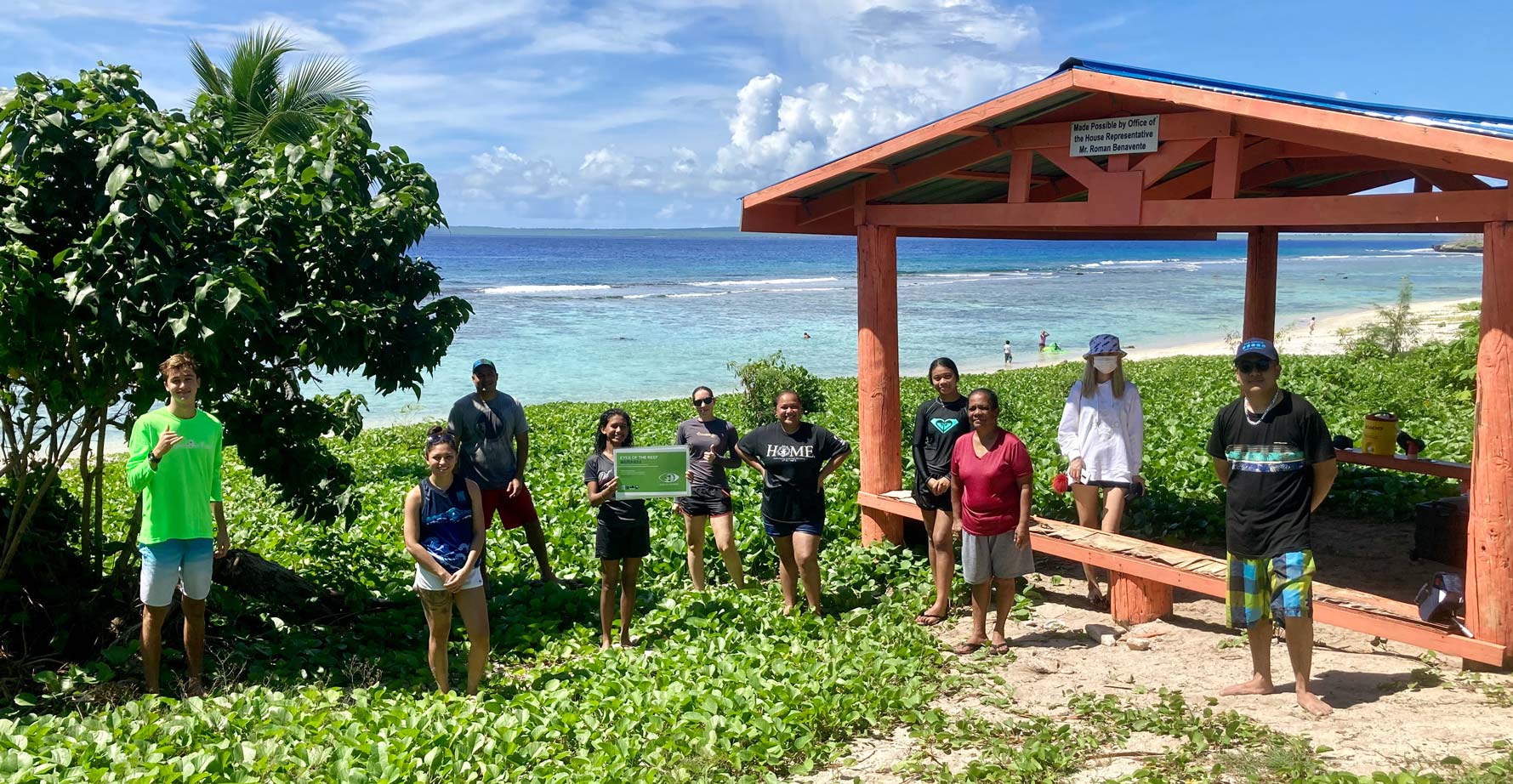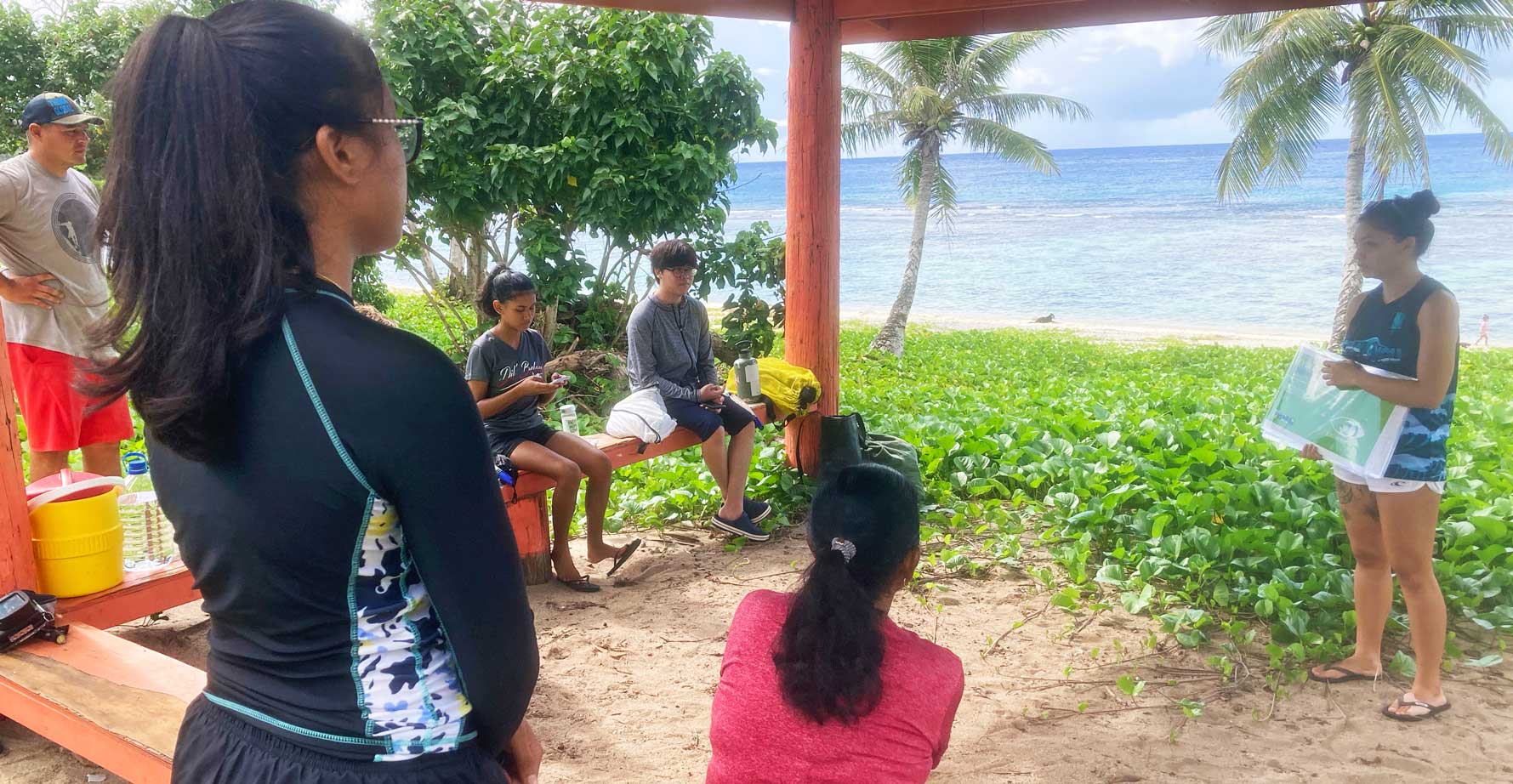Saving our Corals: Eyes of the Reef Marianas

Students from the Northern Marianas College piloted the Eyes of the Reef Marianas program in the CNMI, with training conducted by the Bureau of Environmental and Coastal Quality’s Division of Coastal Resources Management last Saturday at Obyan Beach. (Iva Maurin)
Last Saturday, a small group of students from the Northern Marianas College spent a couple of hours training at Objan Beach to be the “eyes” of the reef here in the CNMI, learning how to spot early signs of coral abnormalities, to help local scientists help our corals. You, too, can be one of them.
Called “Eyes of the Reef Marianas,” the citizen science program empowers community members to get involved in scientific work by becoming part of the community monitoring program.
In this case, it means training the community to spot the early signs of coral bleaching diseases and abnormalities, for crown of thorns starfish outbreaks, and to report them to the Marine Monitoring Program coral biologists at the Division of Coastal Resources Management of the Bureau of Environmental and Coastal Quality.
Coral reefs, here and around the rest of the world, have to deal with different threats, a lot of which are predominantly caused or exacerbated by human activity.
Through the citizen science program, Eyes of the Reef, we can all get trained to know how to detect early signs of bleaching, as well as to identify and report to scientists the threats we see to the corals. Early detection leads to rapid response, and so together, we can help protect and save this precious natural resource.
Mycah Yobech, one of the students who trained over the weekend, stressed the importance of accessing the knowledge, and in being able to aid scientists with their work in rehabilitating and helping corals recover from bleaching events.
“I never realized how much of our coral we lose… With a training like this, we’re able to spot [coral bleaching], and so, when we’re just out and about, if we see an increase of it, we can help scientists by letting them know and then letting them be the ones to act, rather than us doing something reckless. We are the eyes, and they can follow through with the action.”
Coral bleaching and climate change
“Bleaching has nothing to do with Clorox. It’s just a misconception,” was CRM marine biologist technician John Iguel’s straight answer when one of the students asked if the cleaning product is the culprit to coral bleaching.
Corals are being affected by global climate change. The impacts to corals from climate change are extensive, and it’s been happening all over the world, including CNMI waters.
Climate change causes sea level rise, as well as the rise in sea surface temperature, which results in decreased coral growth rate, when corals are unhealthy. When corals go through a bleaching event, they become more defenseless against other diseases and abnormalities, as well as become more susceptible to land-based sources of pollution.
CRM communications specialist Mallory Muña, however, clarifies that coral bleaching is a natural event. Corals, when they bleach, naturally can come back and be healthy corals once more, but in long periods of really hot temperature, in really hot water, the likelihood that they are able to come back and recover from a coral bleaching event and become healthy again gets less and less, the longer they stay bleached.
“Coral bleaching is historically a natural event that occurs to coral reefs like all across the world. However, the problem that we’re experiencing, and what’s making it more of an issue, is that instead of recovering like they normally did, were the microscopic algae returned back to their to the coral, they’re staying away for longer periods of time usually because the water stays hot for longer periods of time, which doesn’t allow the coral to recover.”
The problem that we are experiencing with coral bleaching, for the past few decades, is that water temperatures are getting hotter and staying hotter for longer periods of time, which makes corals less likely to recover from coral bleaching events.
“We’ve had a number of bleaching events in the CNMI. In the last seven years, we’ve had four major bleaching events. One of these bleaching events resulted in a huge decrease in the amount of Staghorn coral cover,” Muña added.
Approximately 85% of staghorn corals in the Saipan lagoon died, as coral reef resources got impacted by severe thermal stress events in 2013 and 2014.
Iguel also highlighted that there are a lot of things going on throughout the year that contributed to the catastrophic bleaching event.
“The tide changed, the tides were longer, and all that made it harder for the reef to flush itself. There’s not a lot of water movement in the lagoon. That’s what kept all that warm water [stay] longer at that time. A lot of factors came into play, and then the storms came and just made it worse.”

Coastal Resources Management communications specialist Mallory Muña talks about how global climate change contributes to coral bleaching, and how this affects the CNMI. (Iva Maurin)
When corals die
In corals live a microscopic algae, which gives it, among a number of things, its color. Coral bleaching happens when that algae leaves the coral animal, usually to get away from the “threat” of an increased temperature. The algae leaving causes the coral to bleach and become white, exposing the coral skeleton.
The algae and the coral are in a symbiotic relationship, one cannot live without the other. The coral can survive for a little bit without the algae, but if it doesn’t come back, it ends up dying. The algae provides them with food and nutrients, which helps it grow. Without that, the coral just can’t survive.
CRM biologist Denise Perez explains that it takes quite a few weeks for it to happen.
“When the first the microscopic algae leave the coral, it can survive for a few weeks like that. But over time, it’s going to starve, and then die. And so then, that’s when you see other types of algae start to grow over it.”
The algae that grows after a coral dies can be exacerbated by land-based sources of pollution such as runoffs. Fertilizer, for example, that washes off from the land to the waters, feeds algae and basically increases the amount of algae that is in the water.
When they die, Perez says it is best to leave the corals where they are. Coral skeletons are also important for the structure of the reef, provides habitat for high diversity, and also helps in absorbing wave energy.
Skeletons or dead corals left in their place provide an opportunity for other organisms to settle on it, and like forests, rejuvenate—find ways for other species to come and replace the area that had been emptied.
“It’s actually better to leave it because there’s preferences for new coral larvae on what they like to settle on, and they like to settle on coral skeletons… Sometimes, there’s a crustose coralline algae, and that actually helps signal coral larvae to settle.
That’s a good kind of algae that you would want around those kind of skeletons.”
Saving the community means protecting our corals
Corals protect the CNMI community by absorbing a lot of the wave energy. It provides protection from storms, helps prevent flooding, and in some places, even helps prevent tsunamis. As a fishing community, we get a lot of resources from the sea, with corals serving as habitats for fish. If corals die, and that habitat gets removed, then, fishing gets affected too.
Not only that, corals also play a major part in the local economy.
“We make most of our money off of here in tourism. Tourists come because we have pristine beaches and water. People come because of the natural beauty and the abundance of resources that they can find… and without a healthy coral reef, we risk losing our number one source of economic revenue,” Muña shares.
“Most of our money are from, and a lot of people work in the tourism industry. Coral reefs are important for protection for fish habitats, but they’re also important for our livelihoods as people, because we live and work and do everything revolving our reefs, revolving our natural resources.”
And so, it really is important to keep the corals healthy, and for everyone to help out, especially since according to Muña, we have a limited number of scientists—biologists who do coral work on the island, and yet, there is a lot to be done. This is where citizen science comes in, where we can all help.
For the “Eyes of the Reef Marianas” program, anyone interested will be trained and capacitated by CRM to assist the biologists to be able to spot and report coral anomalies. As “eyes of the reef,” we can help spot coral bleaching signs, diseases and abnormalities, crown of thorn starfish outbreaks, and other nuisances like green debris or physical damage to the corals, so scientists can check them out and find resolutions to the problem.
To be an eye of the reef, contact Mallory Muna at mmuna@dcrm.gov.mp, or the DCRM Marine Monitoring Program, headed by Lead Biologist Dave Benavente at dbenavente@dcrm.gov.mp. Learn more about the program too by visiting https://eormarianas.org.























